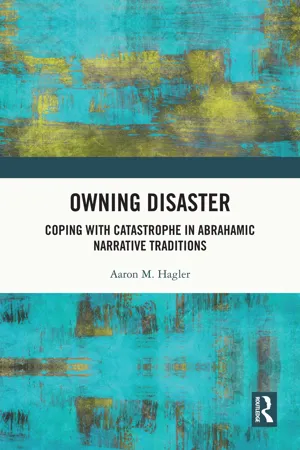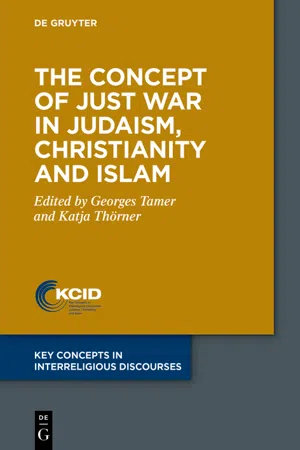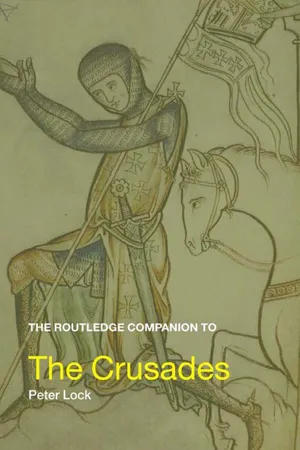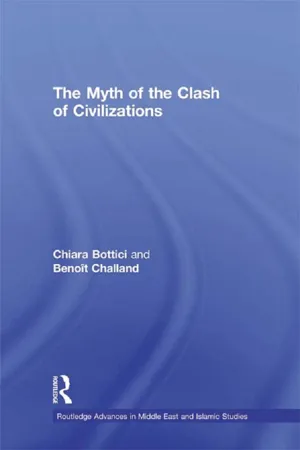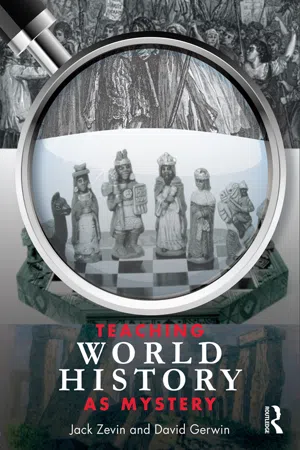History
Muslim Response to the Crusades
The Muslim response to the Crusades was characterized by a combination of resistance, adaptation, and eventual expulsion of the Crusaders from the Holy Land. Muslim leaders such as Saladin organized military campaigns to defend their territories, while also engaging in diplomatic negotiations with the Crusaders. The Crusades had a lasting impact on Muslim societies, shaping their political, social, and cultural development.
Written by Perlego with AI-assistance
Related key terms
5 Key excerpts on "Muslim Response to the Crusades"
- eBook - ePub
Owning Disaster
Coping with Catastrophe in Abrahamic Narrative Traditions
- Aaron M. Hagler(Author)
- 2023(Publication Date)
- Routledge(Publisher)
This is not the case for the Crusades. In Hillenbrand's words, “No aspect of Mediterranean history has been studied more thoroughly than the Crusades, and given their Western origins, it is natural that they should have generated so much scholarship in the West. Yet on the Muslim side too, although medieval writers did not view them as being so momentous—coupling them jointly with the Mongol scourge as hated interventions into the Islamic world by infidel outsiders from outside—there is still much to be said.” 3 The complexity of the period must be borne in mind: Muslim reactions to the Crusades were not monolithic. In truth, the ancient responses to the community-threatening calamities we have already discussed were probably not as monolithic even as they seem to us now, but again, we are limited in our perspectives by the scope and number of surviving sources. The chronology of the Crusades merits only a brief discussion, seeing as how they are amply treated by any number of excellent monographs. 4 The following excerpt is from Carole Hillenbrand's incomparable compendium, The Crusades: Islamic Perspectives. It succinctly provides us with the necessary chronology: A century [after the Prophet's death] the Muslims had crossed the Pyrenees and conquered lands extending from northern India to southern France. For the next two hundred years, the balance of power between Europe and the Islamic world remained decisively in the hands of the Muslims, who enjoyed massive economic growth and whose culture flowered in spectacular fashion - Georges Tamer, Katja Thörner(Authors)
- 2021(Publication Date)
- De Gruyter(Publisher)
We can select a few verses that might help define a theory of just war, as many modern scholars have done. 80 But any conclusion based on such an exercise will not be about the Qurʾān’s view of just war. It is rather the matter of the selective usage of some verse of the Qurʾān in order to construct a theory about just war. 6 The Historical Practice: The Crusader Period The Crusader period is generally hailed as a prominent example of the “inevitable” clash of civilizations between Muslims and Christians. 81 Some historians even consider the overall relation between the members of the two major religious traditions as inherently violent. 82 No doubt, there were countless battles between Muslims and Crusaders. Moreover, as we have seen with the examples of Ibn ʿAsākir, Ibn Taymīya and Ibn Qayyim al-Jawzīya discussed earlier, jihād propaganda and warfare literature witnessed a kind of resurgence at the time. 83 However, violence and hostile rhetoric and preaching was not the only feature of Muslim-Crusader relations. The period also witnessed a heightened level of active diplomacy between the various Muslim rulers in Syria, Egypt and Mesopotamia, and the different Crusader leaders in the Middle East and Europe. 84 This diplomacy engaged a variety of issues that needed to be resolved, such as conflicts, ransoming of captives, commercial and financial grievances. The justifications Muslim scholars gave for peace with the Crusaders have not been studied in modern scholarship in any serious manner. It is an aspect that requires an extensive inquiry- eBook - ePub
- Peter Lock(Author)
- 2013(Publication Date)
- Routledge(Publisher)
272 At first the Franks were just one more pawn in an already overcrowded political chessboard, and were not distinguished from the Byzantines. It was the length and the religious nature of their occupation that gradually provoked an Islamic reaction. In terms of significance to Islam they pale into insignificance besides the Mongols; one has only to contrast the relative ease with which the former crusader states were absorbed in the thirteenth century with the cultural and artistic contributions of the Mongol khanate. In the literature of the West the crusade literature is a genre of its own. In the literatures of Egypt and Iraq they received relatively little attention, and that usually compiled in the thirteenth century. In the literature of Iran they are scarcely mentioned at all.Bad behaviour seemed to know no religious bounds. The rulers and warriors of Islam were no less vicious or ruthless than their crusading counterparts. As successful rulers they could be no other. They sought to be feared rather than loved in the pursuit of their political purposes, and it should come as no surprise that jihad was not at the forefront of their thoughts. Zengi spent his time in attacking his Muslim neighbours rather than the crusader states, with which he sought to remain on good terms. It is only with his attack on Edessa that later writers saw him as the founder of the counter-crusade. As many examples of violence may be plucked from the annals of Islam as from those of the West. Dynastic coups, as in 661 and 750, were accompanied by extreme violence in an attempt to wipe out the opposition. Louis IX and his fellow captives were appalled by the bloodshed that accompanied seizure of power by the Mamelukes at Damietta in 1250. The course of the slave revolt by East African slaves in the saltpetre mines of the Basra region (869–73), known as the Zanj rebellion, showed no mercy to captives and non-combatants and was suppressed as harshly as in any other slave-owning society. Violence, too, was exercised as much against Shi'ite enclaves as against infidels. Both Zengi and Nur ed-Din had a reputation for ruthlessness and violence. If they were not loved they were certainly feared and respected. Many are the folk tales of loyal servants carrying out Zengi's orders to the letter, even if it meant waiting years holding a loaf of bread by a Euphrates ferry station for his return. Ibn Athir (1160–1233) eulogised Zengi for these very qualities.273 Saladin's first thought on attacking Jerusalem was to take it by force. It was only the prevalence of wiser counsels that pointed out that should he not offer terms the defenders of the city would fight to the end; thus a more conciliatory line was taken. Saladin's humanity and magnanimity on this occasion was almost immediately written up to demonstrate the superiority of Muslim over Christian conduct, with direct reference to the events of 1099.274 Control of troops after a hard-pressed siege was as much a problem for Muslim commanders as for Christians. Both Ibn al-Qalanisi's (1073–1160) account of the capture of Edessa on 23 December 1144 and the eyewitness account of Abu al-Fida (fl. 1300) of the sacking of Tripoli in April 1289 and the capture of Acre in June 1291 show the problem well.275 The victory parade of the Mameluke sultan al-Ashraf Salah-ad-Din Khalil (1290–4) in Acre in June 1291, celebrating the final removal of the Franks from Palestine, featured a display of scalps from dead Franks.276 - eBook - ePub
- Chiara Bottici, Benoît Challand(Authors)
- 2013(Publication Date)
- Routledge(Publisher)
4 (the western way of referring to Muslims in this first phase of encounter) kept conquering new territories around the Mediterranean. Latin Christianity gradually fought the influence of Islam by spreading smearing interpretations of Muhammad and Islamic faith, leading to what Rodinson describes as a ‘politico-ideological structural battle’ between the Christian and the Muslim world (Rodinson 2003: 38). With the Crusades, what began as battles about power over land and over theological divisions turned into a more simplistic image of and judgement on Islam which then turned instrumental in creating support for western Christianity at the time of the eleventh- and twelfth-century Crusades.The Crusades created a vast public which needed a synthetic but also entertaining image of the enemy. Doctrines remained what they were for their followers, but for the general public it was necessary for the image proposed to show the detestable character of Islam, at the same time satisfying their literary taste for wonders, so typical of the epoch, and thus also emphasizing the exotic features that shocked the Crusaders in their encounters with Islam. At this time, history was presented as a sort of Manichaean sacred history, in which the representation of the evil of the adversary was a justification of the fatal character of history itself (Rodinson 2003: 41). Thus, a general depiction of Islam as evil, and dehumanizing statements about the Prophet, or even his sexual behaviour, served to take hold of Christian identity.Yet Islam was not only a politico-ideological structure but also a cultural constellation attracting the attention of different scholars and an important zone for trade and commerce. These two other dimensions of Islamdom–Christendom connections contributed to the emergence of different images about Islam. Thus western endeavours to acquire some of the vast Arab knowledge, in particular in the fields of science, navigation and medicine, contributed to the translation of key Arabic treaties into Latin. Philosophy is another field in which Arabic texts turned out to be decisive, in particular for their contribution to the discovery and transmission of ancient Greek philosophy. On the commercial side, there was, from the twelfth century onwards, ‘reciprocal esteem’ between Christian and Muslim traders (Rodinson 2003: 50f). All of these factors contributed to a new phase around 1250 when both sides acknowledged each other’s positive contributions, thus explaining why Dante (1265–1321) and Chaucer (c. 1342–1400) depict certain Arabs or Muslims in a positive light or why the chivalrous grandeur of Saladdin (c - eBook - ePub
- Jack Zevin, David Gerwin(Authors)
- 2010(Publication Date)
- Routledge(Publisher)
(Tyerman, 2006, p. xiii)This is, to say the least, an extraordinarily broad definition that allows almost any, but not all, wars to be called crusades. Strikingly, it says nothing directly about Jerusalem, or Muslims, or any of the other elements that seemed so critical to us when we first thought about this topic. This problem has plagued the great historians who wrote multi-volume histories of the crusades. In an excellent overview of the historical writing, Jonathan Riley-Scott notes that:finding an acceptable general definition of crusading has always been so difficult that it has often been considered best to leave it well alone … Grousset in the 1930s, Steven Runciman in the 1950s … Setton in the 1960s never explicitly stated what they stood for.(Riley-Scott, 2004, p. 308)We find this striking enough to ask, as we have suggested your students ask, what do we understand better if we identify all of these activities as, in very important ways, the same? What do we clarify by claiming that European Catholics in 1096 who responded to a call to capture Jerusalem from the infidel are engaged in the same activity as those fighting the Muslims in Spain, sacking Christian (though not Catholic) Constantinople in 1204, killing European heretic Cathars in France in 1204, fighting pagans in the Baltics, and Russian Christian Orthodox in Norway and Finland, all the way to the fall of Malta in 1798? This is a historian’s dilemma.In some fundamental sense, nobody who took the cross and went to fight in Jerusalem in 1096 is likely to have imagined that their vows and actions would be used to fight against the German emperor in Italy, to attack Christians in Zara and Constantinople and Finland, or to slaughter Cathars in France. Yet the people who took part in those later actions did see similarities in these actions and claimed the mantle of the earliest people to take similar vows. Calling them all “crusaders” adopts a certain understanding that perhaps some later groups had, but may do an injustice to the earlier “people signed with the cross.” What do we do, as historians and teachers, when we decide that something so diverse—battles against real or imagined enemies of the church, internal or external—is fundamentally the same?
Index pages curate the most relevant extracts from our library of academic textbooks. They’ve been created using an in-house natural language model (NLM), each adding context and meaning to key research topics.
